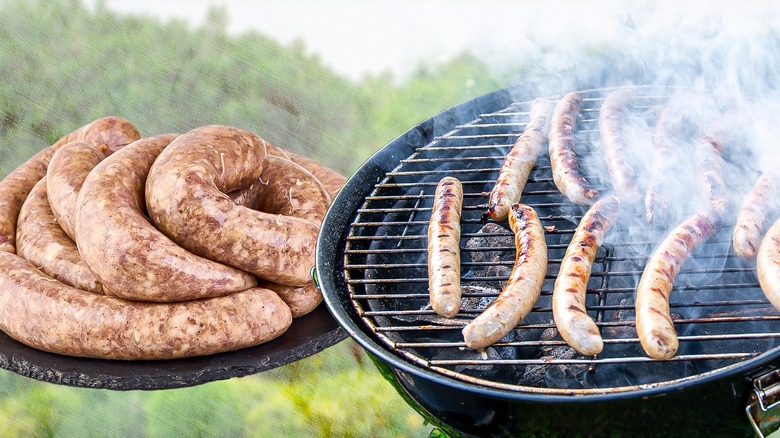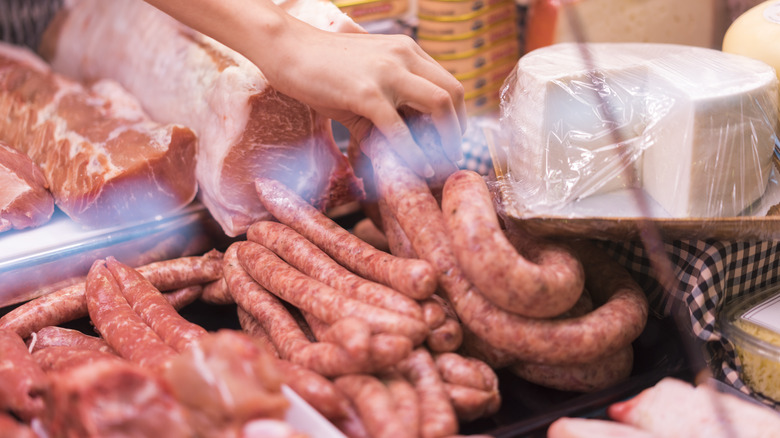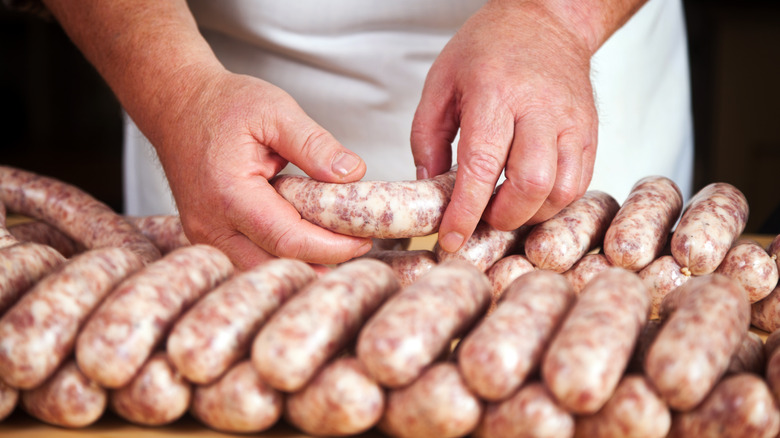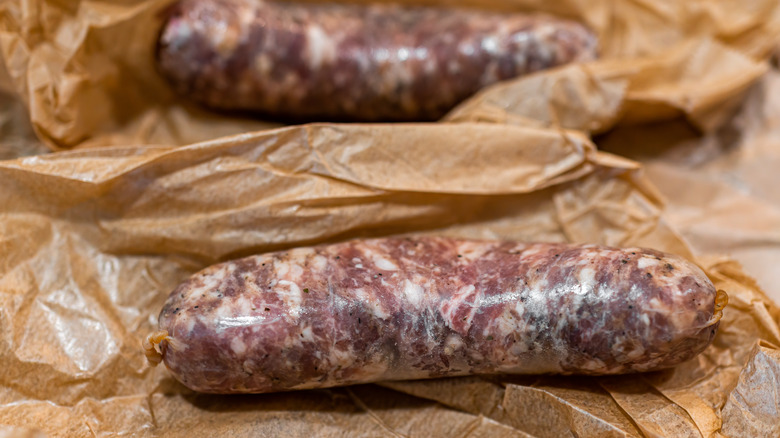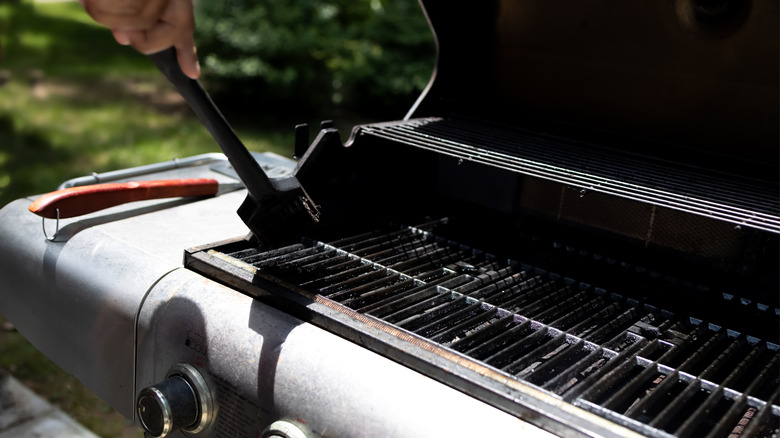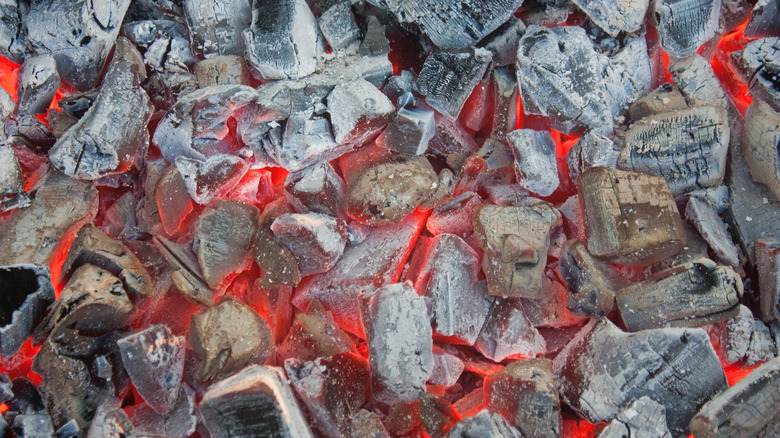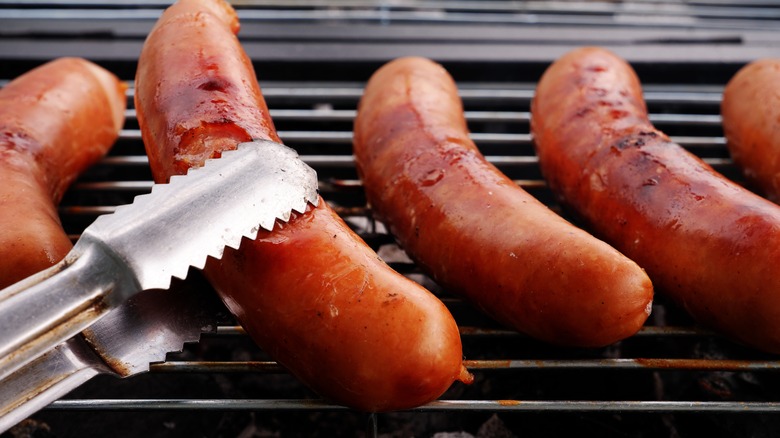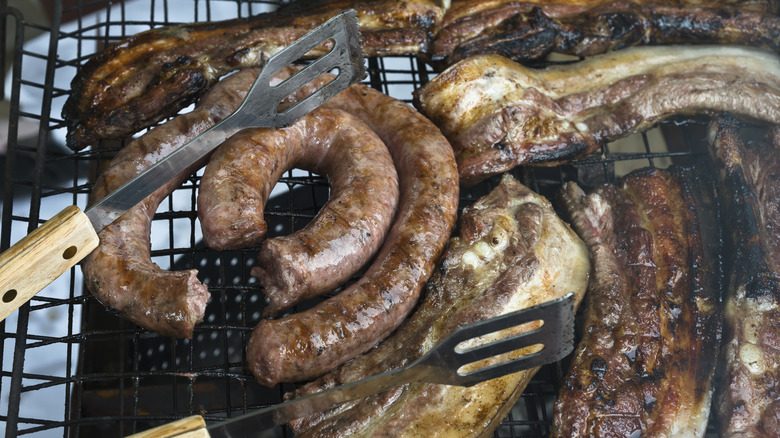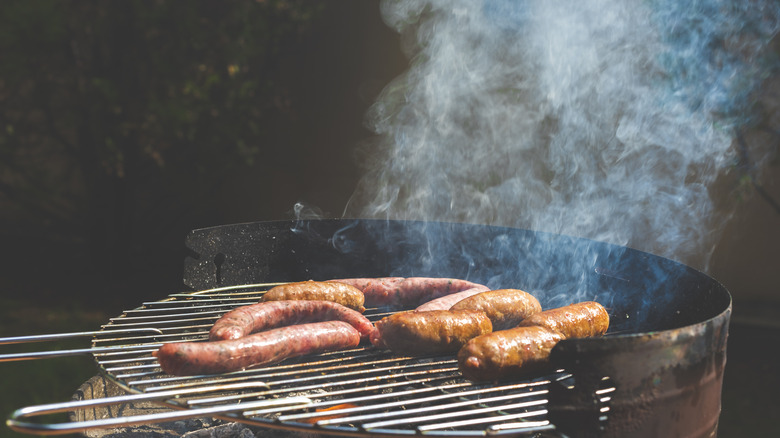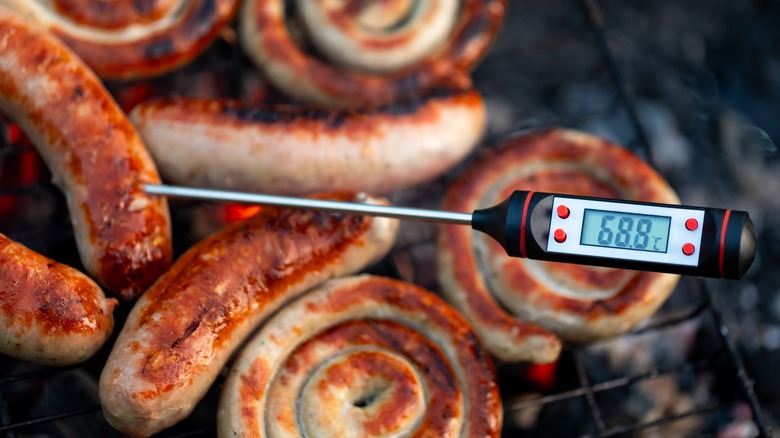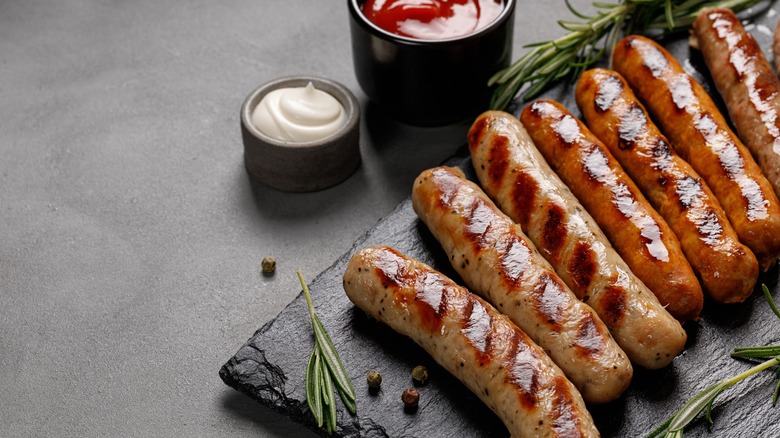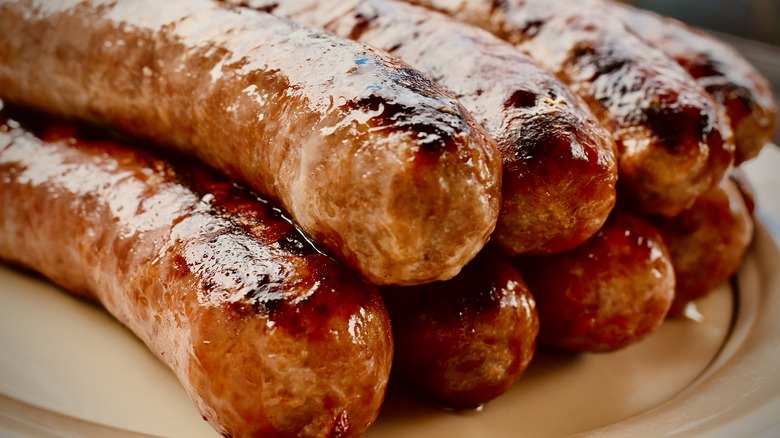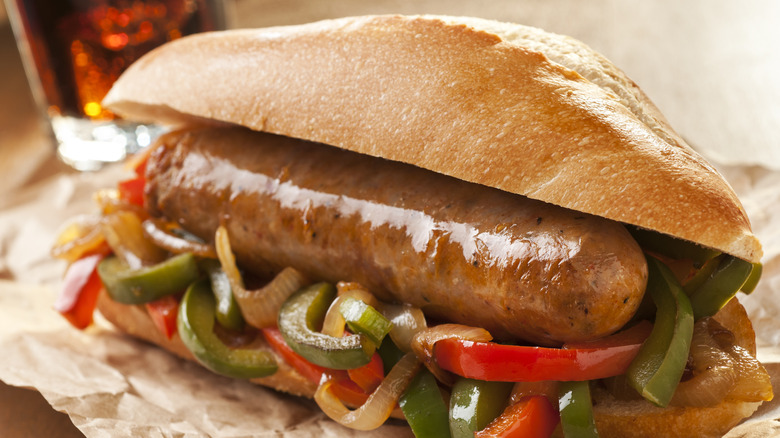12 Absolute Best Tips For Grilling Italian Sausage
There are few simple pleasures in life — and biting into a succulent, grilled sausage and feeling that hot oil gush into your mouth and across your lips is one of them. Italian sausages, specifically, offer a much more divine eating experience than a plain burger or a ho-hum hot dog, especially when they're grilled. But, they're not nearly as popular as other proteins when it comes to backyard barbecues and celebrations. And we can't help but chalk it up to the fact that people just don't know how to preserve that juicy consistency, give each link the perfect char, or serve Italian sausages to their fullest potential.
Surely, a properly grilled Italian sausage requires a little bit more care than a burger, but the flavor and texture that you get from them are sublime and totally worth it. To ease your worries about preparing and grilling sausages, we spoke to several grilling and meat experts on how to properly prepare and grill Italian sausages — including recipe developer Grace Vallo, San Diego chef Brad Wise, and chef David "Fig" Figueroa. So get those tongs, casings, and meat thermometers ready to go — let's fire up the grill!
Don't skimp out on quality sausage
Sausage is about as simple of a meat as you can get. Other items that you grill, like hot dogs and hamburgers, can be smothered with toppings to hide a low-quality base lurking underneath. But sausage? Well, there's no disguising low-quality meat. The sausage needs to be both fresh and juicy to be really worth eating.
You're going to want to opt for the highest quality Italian sausage that you can find. Brad Wise, a San Diego chef, recommends shopping at a local butcher rather than going to a grocery store. "They will know where the hog was sourced from, how it was raised, and how it was harvested," he says. Wise goes on to explain that most butcher stores make their own sausage in-house, which means that it may use "trimmings from the pork steaks (which is a great way to reduce waste), natural casings, and better ingredients like freshly-milled spices and organic herbs."
Chef David "Fig" Figueroa has an even more specific suggestion. "Head to an authentic Italian meat market where they make it fresh on-site," he says. "That's your golden ticket to top-notch flavor. Fresh ground is the best."
If you're making your own sausages, go heavy on the seasoning
If you're looking to take the most simple way out, it's probably not the best idea to undertake the challenge of making sausage from scratch. But for the folks who love a challenge, trying a homemade Italian sausage recipe might just be for you. Traditional Italian sausage is made with a pork base and seasoned with an array of Italian herbs and spices — think all things fennel seed, garlic, and parsley. The spices are really what gives these links their flavor, so you'll want to be generous. Pack in the red pepper flakes and ground paprika to turn a mild sausage into something spicier; you may even reach for cayenne if you're craving heat.
Most people will use pre-ground pork for their sausage. But if you are the proud owner of a stand-alone meat grinder (or KitchenAid attachment), you can start with pork shoulder and some pork belly for extra fat.
Select the right type of casing for your Italian sausages
If you're going the DIY route, you'll also need to read up on the different types of casing out there. We can answer the most obvious question first: Do you need to use a casing at all? Some people get squeamish when they think of wrapping their sausage with animal intestines, but we promise you that it will result in the best flavor possible on your meat. Plus, who can resist that crunch?
The three most common types of sausage casings are natural casings, synthetic casings, and plant-based casings. Natural casings, specifically pork ones, are an ideal choice for your sausages because they will give you the perfect snap when you bite into them. They're also rather durable, provided you don't poke them too hard with a fork.
When your casings arrive, they will either be submerged in a salty solution or packed in salt. You'll want to give them a good rinse to remove this residue and then soak them so that they're flexible and easy to wrap around your filling. Look for a 32 to 35-millimeter casing, as this is the standard for Italian sausages.
Start with a clean grill
The key to grilling anything, whether it's lamb skewers or Italian sausage, is to start off on the right foot. If you neglect to properly clean your grill ahead of time, you may encounter issues with your casings sticking to the grill (which can spell disaster for delicate meat like Italian sausage) or uneven heating.
You'll need to have a few tricks up your sleeve for cleaning your grill. For one, you can slice a lemon in half, dip it in salt, and run it along your grill grates. The acidity will help remove some of the built-up grease while also removing any leftover food residue and pesky bacteria. If you want to ensure that your sausages cook perfectly, you'll also want to be sure to turn up the heat on the grill when you first start it. Then, after you're finished grilling, turn the heat back up to burn off any food residue before you turn off the propane and close up shop for the evening.
Preheat the grill before you start cooking
Preheating is a critical cooking step for most foods, whether you're baking a batch of cookies or searching for the perfect sear on the outside of your grilled Italian sausages. Recipe developer Grace Vallo recommends preheating your grill to a comfortable 375 degrees Fahrenheit before you put your sausages on. "This ensures a good sear and helps lock in juices," she explains.
Many folks will pre-cook their sausages before placing them on the grill. This method will help you better control the cook on your links; if you cook the sausages the whole time on the grill, you may risk drying them out. But, if you just toss them on for the last few minutes of the cooking time, you can get the sear that you're craving. Moreover, you'll want to be sure that pre-cooked sausages are being thrown onto a preheated grill, per Vallo's suggestion, to ensure that they get the perfect crisp coating rather than just overcook.
Resist the urge to cook your sausages too hot
Everyone wants the char — it's totally understandable. But what you don't want to do is cook your Italian sausages too hot and render them dry and flavorless. "Resist the urge to crank up the heat — high temps will burst the delicate casing, letting all those delicious juices escape. Instead, go for medium heat and give them a good turn every so often," says David "Fig" Figueroa. "Patience is your best friend here; you'll end up with perfectly cooked sausage, juicy and full of flavor."
Brad Wise agrees with this. He suggests cooking the sausages "low and slow" over indirect heat. "Direct heat is going to burst the casing, which means you're going to lose all the juices and end up with a dry sausage." Using the two-zone grilling method will give you better control over the color and cook on your sausages. This method is easy to implement on both charcoal and gas grills. For the former, turn one burner on and leave the other one off. And for charcoal, just stack the briquettes on one side.
Try cooking your sausages over coals
Charcoal, gas, electric, oh my! There are so many options when it comes to deciding what the best way to cook your Italian sausages is. Luckily, we deferred to the pros on this one. Brad Wise recommends cooking the sausage over coals. He uses a Big Green Egg to cook his, because he claims the sausage will "pick up some of the flavors from the fire and the smoke." If you really want to capitalize on this smoky flavor, you'll want to cook the sausages as low and slow as possible so they can soak in the flavor.
Another way to impart more flavor onto your Italian sausages is to smoke them. Unlike larger and thicker cuts of meat, like brisket, Italian sausages really don't take that much time to smoke effectively. Smoke sweet or hot Italian sausages for a few hours at around 250 degrees Fahrenheit to get a perfectly crisp outer coating and pop them on the grill if you want a decent char. Hickory would give you a solid all-around flavor, but you could also experiment with other woods as well, like applewood.
Avoid piercing the casings
There are some meats out there that are forgiving. But Italian sausage is not one of them, at least when it comes to grilling. These sausages are packed into casings that, while they may appear durable, are actually rather thin. One wrong move, stick of the tong, or otherwise evasive action could cause your casing to rip open and leave the contents of your sausage to fall between the grill grates and into the flames below. You'll need to be gentle with these sausages to avoid ripping the casing. You should also avoid placing your sausages too close together, as it will not only make it more difficult to grill them but also increase the risk of your sausages sticking to one another and subsequently ripping.
You also have to think about what you're using to flip and rotate your sausages as you're cooking them on the grill. "Avoid poking or piercing sausages with a fork or knife," says Grace Vallo. "This can make them dry. Use tongs to turn them gently."
Use a meat thermometer
It can be difficult to decide when to pull your sausages off the grill. They might look done, but the only real way to tell if your sausages are not only safe to eat but also perfectly cooked all the way through is to use an instant-read thermometer. "The internal temperature should reach 160 degrees Fahrenheit for pork sausages or 165 degrees Fahrenheit for chicken sausages," says Grace Vallo. And yes, before you ask — it is possible to make an Italian-style chicken sausage.
It's really difficult to tell if sausage is done cooking visually for several reasons. Italian sausage is comprised of a ton of fat, typically around 20% to 30%. These lipids will cook much faster than the protein that surrounds them, which causes the links to brown rapidly. When you stick the center of your sausage with the thermometer, you'll get a more accurate indication of doneness; just be sure it holds this temp for about 20 seconds before you shut off the heat.
Let your sausages rest after pulling them off the grill
You spent all that time getting perfect grill marks on your sausage — great! Now, it's time to shut off the heat, stuff your Italian sausage into a sandwich, kick back, and relax. Unfortunately, we have some bad news for you on that one.
You'll need to give your links a little time to rest after you pull them off of the heat. "The general rule is to let sausages rest for half the amount of time you cooked them for," says Brad Wise. "This allows the juices to redistribute so you get a nice, tender sausage." Considering most Italian sausages take anywhere from 10 to 12 minutes to cook, you can expect to dedicate at least 5 minutes of your time to allowing these links to take a little siesta. Plus, it gives you more time to get your toppings in order.
The reasoning for why you should let sausages rest is simple. You should let most types of meat rest after cooking because it gives the muscle fibers a little bit of wiggle room to soak up all of those juices. Otherwise, all of that effort to ensure a perfectly succulent sausage will have been in vain, as it will pour out onto your plate rather than into your mouth.
Get creative with different sauces and seasonings
Once your sausages are rested, succulent, and ready to party, it's time to start getting creative with pairing them with different sauces and spreads. This type of sausage is best served with simple sauces and spreads that can highlight the light yet flavorful spices hidden beneath the casing. If you prefer to keep it simple, you can tuck your Italian links straight into a bun once they come off the grill. We recommend toasting your buns for a little bit so that they are perfectly crisp — just like the casing you're about to sink your teeth into.
"An Italian sausage can be topped with roasted bell peppers and onions, or served with sun-dried tomato pesto," suggests Brad Wise. These vegetable-based accompaniments can offer a reprieve from the fatty sausage, but it is still mild enough to highlight those gentle spice notes. You may also take a page out of Texas barbecue and eat a sausage wrapped up in a plain slice of white sandwich bread, topped with raw onions and pickles or relish. It's the simple things in life, right?
Find innovative ways to serve your sausages
While using a bun as a vessel for your sausage, or just stabbing them with a fork and eating them straight, are two great ideas for serving your sausage, there are far more creative ideas for how you can put these Italian links to use. "Italian sausages are great on pizza," says Brad Wise. How tasty does a pie covered in little sausage coins, thinly sliced peppers, and onions sound?
Grace Vallo suggests taking a Tex-Mex approach to these sausages. "Slice the sausages and serve them in soft tortillas with toppings like grilled corn, avocado, salsa, and a squeeze of lime," she suggests. Moreover, for a heartier meal, try her suggestion of sausage-stuffed peppers. Just hollow out a bell pepper, add your sausages and veggies or choice, and top things off with some rice or quinoa. You could even make little crostini appetizers with a schmear of ricotta and sliced charred sausage. With these simple hacks, your Italian sausage is bound to be the highlight of your barbecue — and more.
